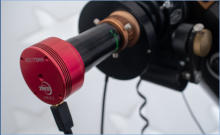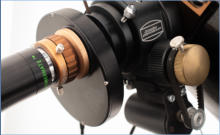Focal extender, electrical filter wheel and
electrical focusser
The Universe at a glance...

Juniper Hill Observatory
Köfering, Bavaria
12° 12’ E
48°56’ N
344m N.N.
Unser Equipment für hochauflösende Mond- und Planetenfotografie
Our equipment for high resolution imaging
Um eine möglichst hohe Auflösung zu erreichen, arbeiten wir im Bereich der Mond- und
Planetenfotografie mit monochromen Bildsensoren in Verbindung mit Interferenzfiltern zur Erfassung
der Farbinformation. Für Monochromaufnahmen am Mond kommt bei suboptimalen
Seeingbedingungen ein IR-Langpassfilter zum Einsatz.
Über entsprechende Brennweitenverlängerung wird das Teleskop perfekt auf die Pixelgröße des
Bildsensor abgestimmt. Derzeit setzen wir eine ASI178MM mit 2.4µm Pixelgröße in Kombination mit
einer 2,5x Powermate ein, um ein Öffnungsverhältnis von f/13.25 bei 2,5m Effektivbrennweite zu
erreichen.
Als Ergänzung zum Einsatz an unserem 6“ f/8-Apochromaten aber auch am 14“-Spiegelteleskop
dient eine ASI 224MC Farbkamera , die sich jenseits 800nm im NIR wie eine Monochromkamera
verhält. Damit sind auch RGB-Methanband-Komposite oder monochrome NIR-Aufnhamen möglich.
Zusätzlich kommt seit Januar 2023 eine ASI 585MC, die sich durch extrem hohe Quanteneffizienz,
eine sehr hohe full well capacity und sehr niedriges Ausleserauschen bei hoher Chipgröße
auszeichnet. DIes ist vor allem für den Einsatz des atmosphärischen Dispersionskorrektors hilfreich.
Um in jeder Konfiguration ein optimales Sampling erreichen zu können, verfügen wir zur
Brennweitenanpassung über mehrere telezentridche Projektionsoptiken von Televue:
Powermates mit einem Verlängerungsfaktor von 2,5x, 4,0x und 5,0x.
For achieving the highest possible resolution we are using monochrome imaging sensors with
interference filters for acquisition of color imformation. The focla extenders are always perfectly
matched to the pixel size of the imager in use.
Currently, we use an ASI178MM monochrome camera, which allows wide image fields on the moon
and high framerates on planets, when cropped down to specific ROI sections. The pixel size of the
chip measures 2.4µm. Given this pixel pitch, a 2.5x Televue Powermate gives the best ratio of pixel
size to effective focal length with f/13.25 at 2.5m effective focal length.
In combination with an electrical focusser and an electrically controlled filter wheel, LRGB-sequences
can be acquired in shortest possible time spans. For monochrome shots of moon details, a NIR-
Longpass filter is also available to calm down the seeing conditions.
In additon - with our 6“ f/8 Apochromat and our 14“ large mirror telescope, we are using an ASI 224MC
color camera, which can be used as a monochrome camera above 800nm. With that camera, we can
achieve RGB-Methaneband compsoits as well as monochrome NIR images - e.g. for luminance.
In addition, we are using an ASI585 MC since beginning of 2023. This camera excels by extremly high
quantum efficiency, high full well capacity and a quite large sensor, which stongly helps when working
with our atmospheric dispersion corrector..
To achieve optimized sampling in either configuration, we are working with several different telecentric
projection optics from Televue:
2.5x, 4x and 5x Powermates.
High resolutioin imaging train














